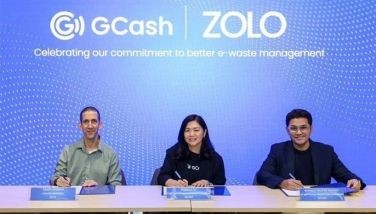Banks still dominate remittance business
January 23, 2007 | 12:00am
The Philippine banking system will continue to dominate the remittance business as commercial banks continue to expand their reach.
Based on a study conducted by the Ateneo de Manila Professional Schools, banks already account for 76 percent of the business.
The study was conducted by Ferdinand Sia of the Ateneo de Manila Professional Schools in coordination with the Economic Policy Reform and Advocacy (EPRA) of the Ateneo de Manila University, and the United States Agency for International Development (USAID).
The country’s banking system, otherwise called the formal sector, handled remittance transactions amounting to over $10 billion. It is anticipated to surpass the $12 billion mark in 2006.
The informal sector is comprised of money transfer operators (MTOs), the so-called door-to-door business, and other forms of non-bank methods. Examples of MTOs are Western Union and MoneyGram.
Global regulations, especially those focused on combatting money laundering, favor the use of the banking systems versus the reliance on the informal sector. In most cases, it is either safer, more convenient or cheaper to use the banking system in both the first and last mile of the system.
The first mile refers to the place of work or residence of the overseas Filipino worker (OFW) or migrant Filipino (MF) such as the United States, Hong Kong or Singapore.
The last mile refers to distribution within the Philippines.
The first mile normally involves foreign and local banks, MTOs and the rest of the informal sector. The last mile generally involves the local banks led by the commercial and thrift banks with the rural banks starting to make a dent in the remittance business.
The study, however, only covers remittances coming from Japan, Hong Kong, Singapore, Malaysia and the US.
Sia said that the average remittances range in the $300 to $326 per month.
Broken down by country, the average amount of remittance are: $567 from Japan; $299, Hong Kong; $294, Singapore; $132, Malaysia; and $342, USA.
The average yearly amount of remittance are: $6,237, Japan; $4,186, Hong Kong; $4,116, Singapore; $1,320, Malaysia; $3,420, USA.
In all five countries surveyed, use of the banking system was dominated with only Hong Kong having more remittances using the MTOs. A few utilized the postal system, friends and co-workers, and recruitment agency or local offices.
In the last mile, banks accounted for over 70 percent of remittance transactions with the remaining through the MTOs.
The study curiously revealed that the principal reasons for choice of money transfer are (in order of priority) easy access to company, speed, reputation, recommendation, favorable exchange rate, and low fees/charges.
The average remittance fees of leading domestic commercial banks based on an average $300 remittance are: Allied Banking Corp., two percent of the value of the remittance; Banco de Oro Universal Bank, no charge; Bank of the Philippine Islands, 1.4 percent; Equitable PCI Bank, 0.7 percent; Metropolitan Bank and Trust Co., 0.7 percent; Philippine National Bank, 1.7 percent; and Rizal Commercial Banking Corp., no charge.
In fees in the first mile of the remittance transaction differ from country to country, whether it be a foreign bank, local bank branch, or MTO.
Western Union slaps an 11-percent of the face amount fee from the US, 18 percent in Japan, 15 percent from Malaysia, 2.7 percent from Singapore, and 1.2 percent from Hong Kong.
MoneyGram charges 3.3 percent from the US, 4.4 percent from Japan, 6.7 percent from Malaysia, 1.8 percent from Singapore, and 1.1 percent from Hong Kong.
Three new members of the informal sector are telecommunication companies (telcos). These are Xoom, Smart Telecommunications (Smart Padala), and Globe Telecommunications (Globe G-Cash).
Remittances are channeled through the carrier’s business centers and tie-up companies that includes non-financial institutions..
For domestic remittance in general, remitters are required to enroll in these financial products. For Globe senders, deposit’s can be done through business centers. When cash is available, remitters transfer cash to another mobile phone holder of the same company via text message (SMS). Beneficiaries receive the cash in real time and can claim the cash through celphone company business centers.
Business centers charge one percent of the remittance amount to sender and another one percent to beneficiary upon claiming of the money.
For Smart, sender deposit cash through Smart business centers. A text message is sent to beneficiary, confirming the deatails of the remittance. Beneficiary can claim the money through Smart business centers, tie-ups, or through withdrawals from Banco de Oro Universal Bank, or ExpressNet ATMs. Sender gets charged one percent for the remittance amount, while beneficiaries get charged another one percent, plus bank withdrawal fees if through ATMs.
Lately, rural banks have opened up alliances with commercial banks, MTOs and IT companies thus expanding the number of players in the remittance business.
Based on a study conducted by the Ateneo de Manila Professional Schools, banks already account for 76 percent of the business.
The study was conducted by Ferdinand Sia of the Ateneo de Manila Professional Schools in coordination with the Economic Policy Reform and Advocacy (EPRA) of the Ateneo de Manila University, and the United States Agency for International Development (USAID).
The country’s banking system, otherwise called the formal sector, handled remittance transactions amounting to over $10 billion. It is anticipated to surpass the $12 billion mark in 2006.
The informal sector is comprised of money transfer operators (MTOs), the so-called door-to-door business, and other forms of non-bank methods. Examples of MTOs are Western Union and MoneyGram.
Global regulations, especially those focused on combatting money laundering, favor the use of the banking systems versus the reliance on the informal sector. In most cases, it is either safer, more convenient or cheaper to use the banking system in both the first and last mile of the system.
The first mile refers to the place of work or residence of the overseas Filipino worker (OFW) or migrant Filipino (MF) such as the United States, Hong Kong or Singapore.
The last mile refers to distribution within the Philippines.
The first mile normally involves foreign and local banks, MTOs and the rest of the informal sector. The last mile generally involves the local banks led by the commercial and thrift banks with the rural banks starting to make a dent in the remittance business.
The study, however, only covers remittances coming from Japan, Hong Kong, Singapore, Malaysia and the US.
Sia said that the average remittances range in the $300 to $326 per month.
Broken down by country, the average amount of remittance are: $567 from Japan; $299, Hong Kong; $294, Singapore; $132, Malaysia; and $342, USA.
The average yearly amount of remittance are: $6,237, Japan; $4,186, Hong Kong; $4,116, Singapore; $1,320, Malaysia; $3,420, USA.
In all five countries surveyed, use of the banking system was dominated with only Hong Kong having more remittances using the MTOs. A few utilized the postal system, friends and co-workers, and recruitment agency or local offices.
In the last mile, banks accounted for over 70 percent of remittance transactions with the remaining through the MTOs.
The study curiously revealed that the principal reasons for choice of money transfer are (in order of priority) easy access to company, speed, reputation, recommendation, favorable exchange rate, and low fees/charges.
The average remittance fees of leading domestic commercial banks based on an average $300 remittance are: Allied Banking Corp., two percent of the value of the remittance; Banco de Oro Universal Bank, no charge; Bank of the Philippine Islands, 1.4 percent; Equitable PCI Bank, 0.7 percent; Metropolitan Bank and Trust Co., 0.7 percent; Philippine National Bank, 1.7 percent; and Rizal Commercial Banking Corp., no charge.
In fees in the first mile of the remittance transaction differ from country to country, whether it be a foreign bank, local bank branch, or MTO.
Western Union slaps an 11-percent of the face amount fee from the US, 18 percent in Japan, 15 percent from Malaysia, 2.7 percent from Singapore, and 1.2 percent from Hong Kong.
MoneyGram charges 3.3 percent from the US, 4.4 percent from Japan, 6.7 percent from Malaysia, 1.8 percent from Singapore, and 1.1 percent from Hong Kong.
Three new members of the informal sector are telecommunication companies (telcos). These are Xoom, Smart Telecommunications (Smart Padala), and Globe Telecommunications (Globe G-Cash).
Remittances are channeled through the carrier’s business centers and tie-up companies that includes non-financial institutions..
For domestic remittance in general, remitters are required to enroll in these financial products. For Globe senders, deposit’s can be done through business centers. When cash is available, remitters transfer cash to another mobile phone holder of the same company via text message (SMS). Beneficiaries receive the cash in real time and can claim the cash through celphone company business centers.
Business centers charge one percent of the remittance amount to sender and another one percent to beneficiary upon claiming of the money.
For Smart, sender deposit cash through Smart business centers. A text message is sent to beneficiary, confirming the deatails of the remittance. Beneficiary can claim the money through Smart business centers, tie-ups, or through withdrawals from Banco de Oro Universal Bank, or ExpressNet ATMs. Sender gets charged one percent for the remittance amount, while beneficiaries get charged another one percent, plus bank withdrawal fees if through ATMs.
Lately, rural banks have opened up alliances with commercial banks, MTOs and IT companies thus expanding the number of players in the remittance business.
BrandSpace Articles
<
>
- Latest
Latest
Latest
December 22, 2024 - 10:14am
December 22, 2024 - 10:14am
December 17, 2024 - 10:00am
December 17, 2024 - 10:00am
December 13, 2024 - 12:19pm
December 13, 2024 - 12:19pm
December 4, 2024 - 4:05pm
December 4, 2024 - 4:05pm
November 25, 2024 - 9:35am
November 25, 2024 - 9:35am
Recommended






























